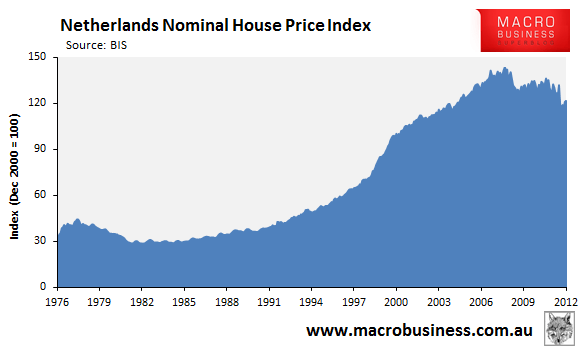
I have noted previously (here, here, and here), how the Netherlands housing system all but guarantees unaffordable housing and a susceptibility to housing bubbles, via:
- ridiculously easy credit, with a third of mortgages guaranteed by the government;
- mortgage interest tax relief and generous subsidies offered to home buyers;
- a dysfunctional rental market that encourages households to strive for owner-occupation; and
- severely restricted housing supply, which ensures that changes in demand flow predominantly into homes prices rather than new construction.
Dutch house prices have fallen sharply since the onset of the Global Financial Crisis (GFC). According to the National Statistics Agency, Dutch house prices fell by -8% in the year to December 2012 to be down -18% since prices peaked in 2008, with nominal prices now back at June 2005 levels (see next chart).

And the sharp fall in house prices is having an adverse impact on the Dutch economy, with household disposable income, consumer confidence, unemployment and economic growth all weakening significantly.
Last month, the Economist reported that the reduction in household wealth was contributing to the downturn in household spending, which is exacerbating the Netherlands’ current economic slowdown:
The Dutch weakness is consumer spending, which has been falling for a year and a half. Household consumption last year was lower than in 2006. Consumer confidence fell to the lowest level ever measured in February. The chief source of anxiety has been house prices. Over the past decade, Dutch housing experienced a bubble comparable to those in Spain or Ireland. But house prices dropped by 6% last year and have fallen by 16.6% from their peak. Feeling poorer, homeowners have simply stopped spending.
The European Commission also recently cut its forecast for the Dutch economy and now expects a second consecutive year of contraction as domestic demand remains depressed. Meanwhile, in its Article IV consultation, concluded last month, the IMF noted that “the ongoing but necessary deleveraging of household and bank balance sheets will continue to weigh on economic activity over the medium term”, whilst also acknowledging that the “banking system still remains heavily exposed to the real estate sector and dependent on wholesale funding, and its process of balance sheet adjustment is also expected to remain in train for the foreseeable future”.
The IMF also forecast Dutch GDP to “contract by 0.5 percent in 2013 before gradually recovering by 1.1 percent in 2014″ and noted that risks are skewed to the downside:
The interaction of household and bank balance sheets linked through changes in house prices makes the outlook subject to unusually large uncertainty. Expectations that house prices need to adjust by more than is currently assumed would restrain both household consumption and lending by banks, which could in turn lead to a continuing cycle of falling house prices and deleveraging.
Yesterday, Spiegel Online provided possibly the most sobering assessment yet of the Dutch economy, which appears to be teetering on the edge of economic crisis similar to that experienced in the US:
“Underwater” is a good description of the crisis in a country where large parts of the territory are below sea level. Ironically, the Netherlands, once a model economy, now faces the kind of real estate crisis that has only affected the United States and Spain until now. Banks in the Netherlands have also pumped billions upon billions in loans into the private and commercial real estate market since the 1990s, without ensuring that borrowers had sufficient collateral.
Private homebuyers, for example, could easily find banks to finance more than 100 percent of a property’s price. “You could readily obtain a loan for five times your annual salary,” says Scheepens, “and all that without a cent of equity.” This was only possible because property owners were able to fully deduct mortgage interest from their taxes.
Instead of paying off the loans, borrowers normally put some of the money into an investment fund, month after month, hoping for a profit. The money was to be used eventually to pay off the loan, at least in part. But it quickly became customary to expect the value of a given property to increase substantially. Many Dutch savers expected that the resale of their homes would generate enough money to pay off the loans, along with a healthy profit…
No nation in the euro zone is as deeply in debt as the Netherlands, where banks have a total of about €650 billion in mortgage loans on their books. Consumer debt amounts to about 250 percent of available income. By comparison, in 2011 even the Spaniards only reached a debt ratio of 125 percent…
Many of the tightly calculated financing models are no longer working out, and citizens can hardly pay their debts anymore. The prices of commercial and private real estate, which were absurdly high for a time, are sinking dramatically. The once-booming economy is stalling…
Johannes Hers of the Centraal Planbureau in The Hague… expects a 0.5-percent decline in growth for 2013. Some 755 companies declared bankruptcy in February, the highest number since records began in 1981. The banking sector is also laying off thousands of employees at the moment.
Because of the many mortgage loans on the books, the financial industry is extremely inflated, so much so that the total assets of all banks are four-and-a-half times the size of economic output.
In February, the government was forced to nationalize SNS Bank, the country’s fourth-largest bank, because it had a large portfolio of bad loans for commercial real estate.
Clearly, there is more pain to come for the Dutch economy, which is now paying the price for years of poor housing policy.

